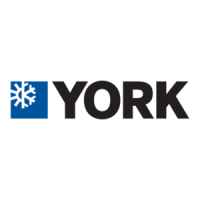YORK INTERNATIONAL
99
FORM 150.62-NM7 (103)
2
1. Low Leaving Chilled Liquid Fault
2. Any compressor is running
3. Daily Schedule is not programmed OFF and
Unit Switch is ON
The pump will not run if the micro panel has been
pow ered up for less than 30 seconds or if the pump
has run in the last 30 sec onds to prevent pump mo tor
over heat ing.
EVAPORATOR HEATER CONTROL
The evaporator heater is controlled by ambient air tem-
per a ture. When the ambient tem per a ture drops be low
40°F (4.4
°C) the heater is turned on. When the tem-
per a ture rises above 45°F (7.2°C) the heat er is turned
off. An under volt age condition will keep the heater off
until full volt age is re stored to the system.
PUMPDOWN CONTROL
Each system has a pump-down feature upon shut-off.
Manual pumpdown from the keypad is possible by turn ing
off the respective system’s switch under the OP TIONS
key. On a non-safe ty, non-unit switch shut down, all com-
pres sors but one in the sys tem will be shut off. The LLSV
or EEV will also be turned off. The fi nal com pres sor will
be al lowed to run until the suc tion pressure falls be low the
cutout, or for 180 sec onds, which ev er comes fi rst.
The EEV pilot solenoid is also used as a low super-
heat safe ty device when the EEV is selected as the
ex pan sion valve type. While the system is running and
not in a pumpdown mode, the EEV pilot solenoid will
close if the suction su per heat falls below 4°F. The EEV
pilot so le noid will open again when the su per heat rises
above 7.0°F. This safety de vice is ignored for the fi rst 30
seconds of system run time. If the EEV pilot solenoid is
closed 10 times in 2 minutes on the safety de vice, the
low su per heat safety will be trig gered.
ELECTRONIC EXPANSION VALVE (EEV)
General
The EEV is optional on the YCAL0043 - YCAL0253 and
standard on the YCAL0287 - YCAL0347. When the EEV
is installed, it is programmed under Service Mode, which
instructs the micro to control the associated outputs.
The EEV controller in the micro is a PI controller. The
integration time is fi xed while gain scheduling varies
the proportional gain based on the superheat error. As
the superheat gets smaller, the proportional gain gets
small er.
The out put of the PI con trol ler may be viewed on the
display and print outs as the EEV out put per cent age.
This output % is converted to a PWM signal that is used
to control the EEV. It can over and under drive the heat
motor for faster valve response. This PWM output is the
per cent age of a 1 sec ond pe ri od that the 24VAC heat
motor power signal is en er gized.
MOP Feature
The controller has an MOP feature that overrides the
superheat control when the MOP setpoint is ex ceed ed.
This is generally only active during hot water starts.
The MOP setpoint is 60°F (15.5°C) saturated suction
temp.
The MOP feature is also used to prevent undershoot
when the suction temperature of a system being start ed
is much higher than the return water temperature. This
provides better start-up superheat control for high am-
bi ent, low water temp start-ups when the superheat
measurement is high due to a warm suction line.
Valve Preheat
The heat motor is pre-heated for moderate and low am-
bient standby conditions. When the ambient is be low
25°F, the heat motor is preheated to 25%. Between 25
and 50°F, (-3.9°C and 10° and the preheat is ramped
from 25% to 0% linearly, preheat at 50°F (10°C) and
above is 0%.
Inputs
Two external inputs to the micro are used to control
the superheat. These inputs are the suction tempera-
ture sensor input and the suction pressure transducer
input.
Outputs
Two output signals are fed to the EEV. The fi rst con-
trols the EEV pilot solenoid portion of the valve and is
115VAC.
The second output is the EEV PWM signal which feeds
the heat motor. The signal will be a 24VAC pulsed sig nal
that is fed to the valve heat motor within a 1 second
period. This 24VAC signal can be fed to the motor 0%
to 100% of the 1-second period. The signal is mea sured
in terms of watts with 100% equating to 30W, 50% to
15W, etc.
The EEV PWM signal is used to overdrive the valve
for faster response. It also allows the valve to stabilize
and control superheat more accurately. This feature is
especially valuable at start and during transients when
valve overfeed could cause liquid to be fed to the
compressor.

